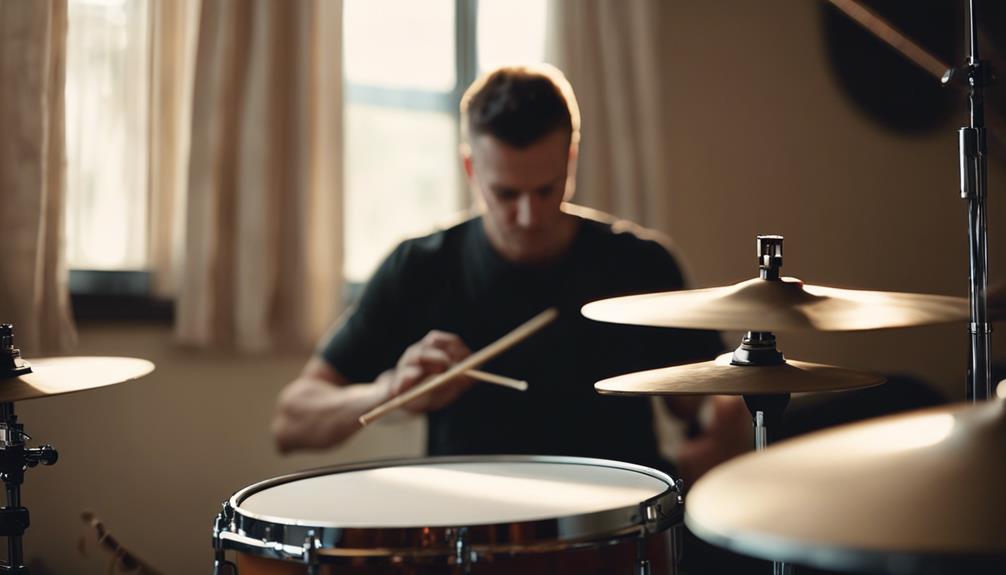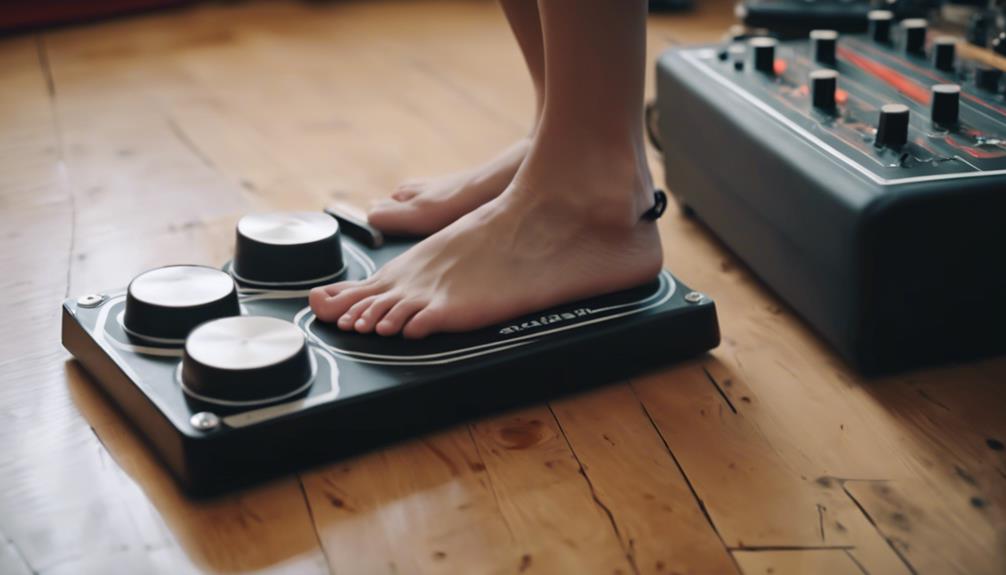When you don’t have access to a drum kit, practicing drums can still be highly effective. Start by using a practice pad, which is excellent for focusing on stick control and technique. Everyday items like pillows and cushions can mimic drum surfaces, helping you refine hand coordination. Don’t underestimate the power of air drumming for muscle memory and rhythm, and consider rhythmic vocal exercises and clapping to enhance your timing. Each of these methods offers unique benefits and can greatly improve your drumming skills, but how do you make sure you’re getting the most out of these alternative practices?
TL-DR
- Use a practice pad for focused technique and stick control improvement.
- Engage in air drumming to enhance coordination, timing, and rhythm.
- Simulate a drum kit with household items like pots, pans, and pillows.
- Practice clapping and singing rhythms to develop internal timing.
- Perform foot development drills to enhance bass drum technique and coordination.
Practice Pad Benefits

Using a practice pad lets you focus on technique and stick control without the need for a full drum kit. It’s a cost-effective solution that allows you to hone your drumming skills without investing in an expensive setup. Practice pads offer a smooth surface ideal for refining your strokes and improving precision. You’ll find that working on a pad can greatly enhance your stick control, giving you the confidence to tackle more complex rhythms and patterns.
One of the biggest advantages of practice pads is their portability. You can take them anywhere, meaning you can practice without a drum set, whether you’re at home, traveling, or even backstage before a performance. This flexibility ensures that you can keep up with your practice routine no matter where you are.
Another great feature is the low volume level. Practice pads are designed to produce minimal noise, making them perfect for noise-free practice sessions. You won’t have to worry about disturbing neighbors or family members. Plus, the rubber material of these pads guarantees they’re durable and can withstand long-term use, making them a reliable tool in your drumming arsenal.
Stick Selection Tips
Choosing the right drumsticks can greatly impact your practice sessions, especially when you’re without a full drum kit. Stick selection is vital to make sure you’re getting the most out of your practice time.
For instance, drumsticks with nylon tips are a great choice due to their durability and clear cymbal articulation, which is beneficial even if you’re just practicing on a pad. They can handle the repetitive strikes without wearing out quickly.
When you practice drums without a full kit, consider using lighter drumsticks. Lighter sticks help reduce hand fatigue and strain, enabling you to practice for longer periods comfortably. Additionally, sticks with a balanced weight distribution improve your control and precision, allowing you to master techniques more efficiently.
It’s also worth experimenting with different stick sizes and materials. This experimentation helps you find the most comfortable and suitable option for your practice needs. Comfort is key, so select sticks that have a comfortable grip and ergonomic design. This will enhance your drumming experience, even without a full kit.
Proper Stick Grip

Mastering proper stick grip is essential for maximizing control, precision, and comfort during your drum practice sessions. One of the most common grips is the matched grip, where you hold both sticks similarly, with your palms facing down and thumbs on top. This grip offers balanced control and is suitable for various drumming styles.
Another option is the traditional grip, where you hold the left stick between your thumb and index finger, letting it rest on the ring finger and using the pinky for support. This grip is often used in jazz and marching band settings. Proper grip alignment is vital here; make sure the sticks are parallel to each other and perpendicular to your practice pad or imaginary drum.
The French grip involves holding the sticks with your palms facing inward, primarily using your fingers for control and rebound. This grip can provide excellent finesse and is great for quick, articulate playing.
Experiment with different grips to find which one feels most comfortable and effective for you. Whether you choose matched, traditional, or French grip, focus on maintaining proper grip alignment to ensure smooth and efficient practice sessions. Your grip directly influences your technique, so take the time to get it right.
Posture and Positioning
When practicing drums without a kit, make sure you’re sitting correctly with your feet flat on the ground for stability.
Keep your wrists straight and elbows close to your body to enhance stick control and avoid strain.
Position your practice pad at waist level to align with your natural drumming motion, ensuring a seamless practice session.
Sitting Correctly
Maintaining proper posture while practicing drums without a kit is essential for preventing injury and ensuring effective practice sessions. When you sit correctly, it helps you avoid strain and maximizes your drumming efficiency.
Follow these guidelines to perfect your posture:
- Sit with your back straight and shoulders relaxed: This helps you maintain a natural and comfortable position, reducing the risk of back pain and tension in your shoulders.
- Position your practice pad at waist level: This guarantees your hands move comfortably and efficiently, which is vital when drumming without a full kit. It also helps maintain proper stick control.
- Place the practice pad on a stable surface: Ensuring your practice pad doesn’t slide or move keeps your practice focused and uninterrupted.
- Keep your elbows close to your body and at a 90-degree angle: This positioning allows for the best stick control and wrist motion, making your practice sessions more effective.
Additionally, adjust your seating height so your thighs are parallel to the ground and your feet are flat on the floor. This ergonomic setup supports your overall posture and makes your drumming practice more comfortable.
Arm and Wrist Alignment
Proper arm and wrist alignment is essential for effective drumming technique and injury prevention. When practicing without a kit, you need to focus on ensuring your arms are relaxed and positioned naturally. Start by letting your arms hang loosely at your sides, then raise them to a comfortable angle as if you’re about to play on an ideal drum set. This will help you maintain proper posture.
Keep your wrists straight to avoid unnecessary strain. When your wrists are aligned correctly, it promotes fluid movement, allowing you to play faster and more accurately. Imagine your drumsticks extending naturally from your arms; this will help you maintain a straight wrist position.
Position your arms so they’re parallel to the drum surface. This alignment gives you excellent control and power, making each stroke more effective. Even without drums, you can practice this by visualizing a drum set in front of you and mimicking the motions.
Multiple Stroke Exercises

Start by focusing on stick control techniques to improve your hand conditioning and control.
Practice multiple stroke exercises to enhance your hand-foot coordination, which is essential for fluid drumming.
Stick Control Techniques
Practicing multiple stroke exercises on a practice pad boosts your hand conditioning and control for better drumming. These stick control techniques are essential for enhancing your hand speed, dexterity, and fluidity.
To get started, focus on executing multiple strokes with consistent sound and rhythm. Here are some techniques you can incorporate into your practice routine:
- Single Stroke Roll: Alternate strokes between your right and left hands. This simple yet effective exercise helps develop speed and coordination.
- Double Stroke Roll: Play two strokes with each hand, ensuring both strokes are even. This exercise is great for building smoothness and control.
- Triple Stroke Roll: Add an extra stroke to each hand before switching. This helps increase your ability to maintain rhythm and consistency.
- Five-Stroke Roll: Combine double strokes and a single stroke to create a pattern. This advanced exercise challenges your precision and timing.
As you practice, gradually increase the speed and complexity of these stroke patterns to continually challenge yourself and improve your hand technique. By incorporating multiple stroke exercises into your daily routine, you’ll build muscle memory and precision, essential for any drummer.
Stick with it, and you’ll see significant progress in your drumming skills.
Hand-Foot Coordination
Enhancing hand-foot coordination through multiple stroke exercises allows drummers to develop seamless control and synchronization between their limbs. By focusing on various sticking patterns, you can greatly improve your speed, accuracy, and overall control. Practicing these exercises regularly will help you achieve better limb independence, which is important for playing complex rhythms and drum patterns.
To start, try simple patterns like alternating single strokes between your hands and feet. For example, play right hand, right foot, left hand, left foot. Gradually increase the speed as you become more comfortable. As you progress, introduce more complicated sticking combinations, such as double strokes or paradiddles, incorporating both hands and feet.
Consistency is key. Set aside dedicated practice time for these exercises, and you’ll notice a marked improvement in your ability to play challenging rhythms seamlessly.
Incorporate these multiple stroke exercises into your routine, and you’ll find that your hand-foot coordination and limb independence will enhance your overall drumming skills.
Mastering Rudiments
Mastering rudiments is essential for any drummer looking to build a solid foundation and elevate their overall skill set. Rudiments are the building blocks of drumming, comprising fundamental patterns and exercises that improve your hand speed, coordination, and control.
By mastering rudiments, you’ll enhance your ability to play more complex rhythms and patterns with precision and fluidity.
To get started, focus on the 40 standard rudiments recognized by the Percussive Arts Society. These range from simple single strokes to more complex combinations like paradiddles and flams. Here’s how you can integrate them into your practice routine:
- Daily Practice: Dedicate at least 15 minutes each day to practicing rudiments. Consistency is key to mastering these fundamental patterns.
- Use a Metronome: Practice with a metronome to develop your timing and make sure that you’re playing at a steady tempo.
- Start Slow: Begin at a slow tempo to maintain accuracy, then gradually increase the speed as you become more comfortable.
- Focus on Technique: Pay attention to your grip, stick height, and stroke consistency to maximize control and efficiency.
Pillow Practice Techniques

Why not give pillow practice a try to boost your drumming technique and control? Pillow practice is an excellent way to strengthen your hand muscles and improve your stick control without the need for an actual drum kit.
By using pillows as a drumming surface, you can work on your technique, precision, and speed in a quiet and cost-effective manner.
When you practice on pillows, you’re simulating the rebound and response of a drumhead, but with added resistance. This extra resistance forces you to focus on your hand technique, making your muscles work harder. As a result, when you switch back to a drum kit, you’ll find your control and speed have significantly enhanced.
To get the most out of pillow practice, incorporate rudiments, multiple stroke exercises, and various hand conditioning routines. This will help you develop a more refined and dynamic drumming style.
Practicing on pillows also minimizes noise, making it a convenient option for those living in close quarters or needing to practice late at night.
Air Drumming
Engaging in air drumming allows you to practice your drumming skills virtually anywhere, anytime. By mimicking drumming motions without using actual drums or equipment, you can hone your coordination, timing, and rhythm. This technique engages your muscles and motor skills, helping to establish muscle memory essential for proficient drumming.
To make the most out of air drumming, follow these steps:
- Visualize Your Drum Kit: Imagine your drum set in front of you. Visualize each drum and cymbal’s position to replicate the actual movements required.
- Practice Drum Patterns: Focus on specific drum patterns or rudiments. This will help you internalize various rhythms and improve your timing.
- Engage Your Whole Body: Use your arms, wrists, and even legs as if you’re playing on a real kit. This ensures you’re practicing with the correct form and motion.
- Consistent Practice: Make air drumming a regular part of your practice routine. Regular practice helps reinforce muscle memory and solidifies your skills.
Many professional drummers incorporate air drumming into their routines, making it a proven method to enhance your drumming capabilities without needing a physical kit.
Using Household Items

Incorporating household items into your practice routine can effectively simulate a drum kit and enhance your drumming skills. You don’t need an expensive drum set to practice; everyday objects around the house can serve as makeshift drums.
Use pots, pans, and buckets to create a variety of drum sounds. Each item has a unique tone, allowing you to experiment with different rhythms and dynamics.
Set up pillows, cushions, or cardboard boxes to mimic drum surfaces. These items can absorb the impact of your strikes, providing a realistic drumming experience without disturbing others.
Tap on tables, chairs, or books to practice different drumming rhythms and hand coordination. The variety of surfaces will help you develop a better feel for different textures and resistance levels.
For drumsticks, grab some wooden spoons, chopsticks, or even pencils. These household items can effectively substitute for actual drumsticks, allowing you to practice your grip and control.
Additionally, explore using empty plastic containers, water bottles, or plastic cups as percussion instruments. These objects can produce a range of sounds, helping you diversify your practice sessions.
Vocal Exercises for Timing
To improve your timing, start by counting rhythms aloud to internalize the beat.
You can enhance this practice by using metronome apps to keep a consistent tempo.
Vocal exercises like these can be done anywhere, making them a practical addition to your drumming routine.
Counting Rhythms Aloud
Counting rhythms aloud is a powerful way to enhance your timing and internalize rhythmic patterns, even without a drum kit. Vocal exercises for timing involve speaking or chanting rhythmic patterns while tapping out the corresponding beats. This practice helps you strengthen your sense of time and develop a deeper understanding of musical structures.
To get started, follow these steps:
- Start Simple: Begin with basic rhythms like quarter notes and eighth notes. Count ‘1, 2, 3, 4’ for quarter notes and ‘1-and, 2-and, 3-and, 4-and’ for eighth notes. This helps you grasp simple time signatures.
- Use Clapping: Combine vocal counting with clapping your hands. Clap on each beat as you count aloud. This adds a physical element, enhancing coordination between vocalizing rhythms and playing drum patterns.
- Increase Complexity: Gradually introduce more complex rhythms, such as triplets and sixteenth notes. This will challenge your timing skills and help you internalize diverse rhythmic patterns.
- Practice with Music: Play along with your favorite songs, counting aloud to match the rhythm. This makes the exercise more enjoyable and practical, as you’re working with actual musical contexts.
Using Metronome Apps
Harness the power of metronome apps to fine-tune your timing and sharpen your rhythmic accuracy. These apps are invaluable tools when you practice drumming, offering a steady beat to guide your timing.
Start by setting the metronome to a comfortable tempo and practice syncing your vocal sounds with each click. This helps internalize the beat and improves your ability to stay on time.
Experiment with different tempos and time signatures to add diversity to your practice drumming. For instance, try 4/4, 3/4, or even 7/8 time signatures to challenge your rhythmic versatility.
Using vocal exercises, such as saying ‘1-e-and-a, 2-e-and-a,’ while following the metronome, can significantly enhance your timing skills.
Focus on maintaining precise rhythmic control by ensuring your vocal sounds align perfectly with the metronome clicks. This practice will help you develop a strong sense of timing, which is critical for any drummer.
Over time, you’ll find that your overall musicality and timing improve significantly.
Foot Development Drills

Enhancing your bass drum control and overall drumming performance starts with dedicated foot development drills that don’t require a drum kit. These exercises focus on improving your foot technique, speed, and accuracy, all essential for mastering bass drum control. Practicing these drills consistently can greatly enhance your coordination and strength in your lower limbs, leading to a more fluid and controlled drumming style.
To get started, incorporate the following foot development exercises into your practice routine:
- Heel-Toe Technique Practice:
This technique involves using both the heel and toe to create smooth, rapid strokes on the bass drum pedal. Practicing this on a hard surface can help you understand the motion and improve your speed.
- Ankle Flexibility Exercises:
Simple stretches and movements can increase your ankle flexibility, allowing for more precise and powerful bass drum strokes.
- Coordination Drills:
Practice tapping your foot in different rhythms while keeping a steady hand clapping or tapping pattern. This improves your ability to coordinate foot and hand movements.
- Strength Training:
Exercises like calf raises and toe taps can strengthen the muscles used in drumming, leading to better endurance and control.
Clapping and Singing
When you clap and sing, you can master rhythmic patterns and improve your internal timing. This practice enhances your musicality skills by syncing your claps with vocal melodies.
Master Rhythmic Patterns
Clapping rhythmic patterns while singing melodies is a powerful way to improve your coordination and timing. When practicing drumming without a drum kit, you can still develop your skills by mastering rhythmic patterns through clapping and singing. This approach enhances your sense of rhythm, making it easier to translate patterns to the drum kit later.
To start, focus on clapping slow quarter notes while singing simple melodies. This basic exercise will build a solid foundation. As you get comfortable, increase the complexity of the rhythms and melodies.
Here’s a structured way to practice:
- Start Simple: Clap quarter notes while singing a straightforward melody. Keep it slow and steady.
- Add Complexity: Introduce more intricate rhythms, like eighth notes and triplets. Clap these patterns while singing the same melody.
- Vary the Melodies: Change the melody while maintaining the rhythmic patterns. This improves your ability to separate rhythm from melody.
- Syncopation Practice: Include syncopated rhythms to challenge your coordination and timing further.
Develop Internal Timing
Building on your rhythmic foundation, developing internal timing through clapping and singing will further refine your drumming skills. Start by clapping rhythms while singing melodies to enhance your sense of time and rhythm. Begin with slow quarter notes, clapping to a steady beat, which helps develop internal timing and reinforces your rhythmic vocabulary.
Incorporate vocal exercises into your practice. Using soundoffs, like those with Evans Soundoff Pads, can be particularly effective. These exercises will improve your timing skills by challenging you to maintain a consistent tempo while vocalizing and clapping simultaneously.
Experiment by clapping different rhythms while singing simple melodies. This coordination exercise strengthens your timing and rhythm skills, ensuring your internal metronome becomes more precise. Try varying the complexity of the rhythms you clap and the melodies you sing to gradually build your proficiency.
Don’t shy away from challenging yourself with intricate clapping patterns. These advanced exercises will push your boundaries and further solidify your internal sense of timing. The more you practice clapping rhythms and singing melodies, the more intuitive your timing becomes, ultimately enhancing your overall drumming ability.
Enhance Musicality Skills
To enhance your musicality, integrate clapping and singing into your daily practice routine. Clapping rhythms and singing melodies are powerful tools that help internalize musical patterns and improve your rhythmic vocabulary.
Here’s how you can incorporate these techniques effectively:
- Clap Rhythms: Start by clapping slow quarter notes. This will enhance your timing and precision, essential for any drummer. Gradually increase the complexity of the rhythms as you become more comfortable.
- Sing Melodies: While clapping, try singing simple melodies. This combination will improve your sense of time and coordination, making your drumming more fluid and musical.
- Alternate Patterns: Switch between clapping and singing different patterns. For example, clap a steady rhythm while singing syncopated melodies. This exercise will challenge your brain and develop your multitasking abilities.
- Use Soundoffs: If you have access to a drum kit, use soundoffs like Evans Soundoff Pads to reduce the volume. This allows you to practice clapping and singing without disturbing others, while still providing a tactile experience.
Rock Band Practice

Playing Rock Band offers an engaging and effective way to practice drumming without the need for a physical drum kit. By using this interactive game, you can learn basic drumming coordination and timing fundamentals. Rock Band simulates playing drums along with popular songs in a virtual setting, making it a fun alternative to traditional practice methods.
One of the main benefits of using Rock Band for drum practice is its ability to improve your rhythm and coordination skills. The game challenges you to hit the correct pads in time with on-screen prompts, which helps you develop a sense of timing and precision. This practice can be especially beneficial for beginners, giving you a feel for drumming before investing in a full drum kit.
Moreover, Rock Band provides immediate feedback on your performance, allowing you to identify areas where you need improvement. The interactive nature of the game keeps you engaged and motivated, making practice sessions enjoyable rather than tedious.
Whether you’re jamming to classic rock anthems or modern hits, Rock Band offers a practical and entertaining way to hone your drumming skills without the need for expensive equipment.
Electronic Drum Alternatives
If you’re looking for a more realistic drumming experience without the bulk and noise of an acoustic kit, electronic drums offer a fantastic alternative. These kits provide realistic drum sounds and response, giving you the feel of an acoustic set without the volume. Here’s why electronic drums can be a game-changer for your practice routine:
- Volume Control:
Electronic drum sets allow you to adjust the volume, making them perfect for apartments, shared living spaces, or late-night practice sessions. You can even use headphones for a considerably silent practice.
- Versatility:
With electronic drums, you can customize sounds, connect to devices for recording, or play along with your favorite tracks. This versatility makes your practice sessions more engaging and productive.
- Built-in Features:
Many electronic drum kits come with built-in practice features like metronomes, play-along tracks, and coaching functions. These tools can notably enhance your skill development.
- Realistic Feel:
While electronic drums can be more expensive than practice pads, they offer a closer feel to playing acoustic drums. This makes them a valuable tool for serious drummers dedicated to honing their craft.
Incorporating an electronic drum kit into your practice routine can elevate your drumming skills while maintaining peace with your neighbors.
Next up, learn how to prevent drumming injuries in this guide.
